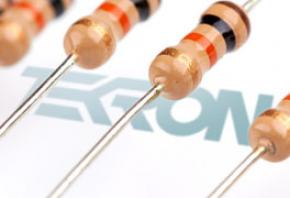AM IRIG-B Terminating Resistor Calculation
Selecting a terminating resistor for AM IRIG-B is slightly different to that of a DCLS signal. It’s better to think of the terminating resistor as a voltage divider, which is used to match the line voltage to the input requirements of the slave devices.
To explain this, let’s work through an example calculation! In figure 1 you can see that the terminating resistor is attached across the line at the end of the IRIG-B bus. By attaching it here it’s effectively creating a divider for which the ratio is defined by the total resistance of the line, as well as the clocks’ internal resistance.
Figure 1 – Example implementation for a termination resistor at the end of an IRIG-B bus.
Before starting this calculation you will need to know the following information:
- The internal impedance of the clock’s output. In the case of Tekron’s range this is 120 Ω
- The input impedance of each IED that is connected to the IRIG-B bus. For most relays this will be in the range of kΩ’s. For this example we are assuming all the relays have a 6 kΩ input impedance. This can be found on most relay manufacturers datasheets.
- The input voltage requirements of the IED’s. This is where you need to determine the maximum voltage input that the relay allows. This can be anywhere from 5 Vdc to 10 Vdc. This can be found on most relay manufacturers datasheets.
- The output voltage of the clock. In the case of Tekron this is 8 Vpeak to peak
Now that you have this information, the first step is to calculate the total load on the IRIG-B bus. This can be done by adding together all the input impedance's of the slave devices. As they are connected in parallel we would expect the equation to look like this:
Where:
- RL is the total calculated load
- R1 to Rn are the input impedance's of the slave devices.
In our example, we have 5 protection relays each with an input impedance of 6 kΩ. This makes our equation:
Solving for RL:
Now that we know what RL is, we can work out the required terminating resistor by using the following equation:
Where:
- Vreq is the minimum required voltage for the slave device to operate
- Vout is the AM IRIG-B output voltage
- Rs is the output Impedance of the AM IRIG-B output
- RL is the total calculate load
- Rterm is the value we are solving for, which is the terminating resistor
In this example, we will use the following values:
- Vreq = 6 Vdc
- Vout = 8 Vpeak to peak
- Rs = 120 Ω
- RL = 1,200 Ω
This gives us the following calculation:
From the E24 resistor range, the closest match is a 510 Ω resistor which will be sufficient to achieve the required voltage level.
This blog is an extract from our whitepaper "(Almost) Everything You Need to Know About IRIG-B" which you can download here








